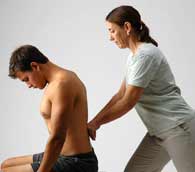What is rolfing? Is it the same as massage therapy?
No way rolfing is hard tissue workout. You’ll want to learn more on the theory of alignment in Rolfing Therapy and why it is an important healing method.
Rolfing is a manipulation therapy of the soft connective tissue throughout the body. This therapy is also combined with movement techniques to improve posture.
Dr. Ida Rolf, a biochemist, developed this form of therapy many years ago in 1960’s . It is also known as Rolfing Structural Integration and has spread throughout the world with more than one thousand certified Rolfers in 26 countries.
Basis of Rolfing Therapy
This therapy is based on the fact that our modern sedentary lifestyle, sitting at our desks and looking at screens, has resulted in poor posture.
When bad posture becomes habitual then the body’s muscles can develop patterns of unnatural contractions. The connective tissues in the bodies become malformed and form thick plates known as fascia. The fascia serve to reinforce the bad posture and especially the muscular imbalance. They also affect the skeletal system.
The purpose of Rolfing therapy is to break down these fascias and to restructure the muscles and body to improve posture. This in turn also improves general health. Essentially Rolfing aims to restructure and realign the body with its center of gravity and with the earth. This therapy also aims, through restructuring the body, to reveal other physical and psychological problems.
How it Works
The basis of Rolfing therapy is very simple.
The muscles usually work in pairs. For example, as one muscle contracts so an opposite muscle lengthens in the body. For example, as you bend your elbow the biceps or muscles at the front of the arms lengthen. This is a natural process of balance and harmony in the structural alignment of the body.
However, if an unnatural action takes place in the muscular unity of the body- if, for example, the head is pushed out over a period of time, the body will become out of alignment with the force of gravity. If this unnatural posture is maintained over a period of time, the muscles will remain contracted and not relaxed. The fascia surrounding each muscle will shorten and lose flexibility.
More importantly, this unnatural posture will become a new “learned” posture, which the neuromuscular system begins to accept as normal.
Rolfers believe that this unnatural situation within the body creates not only muscular dysfunction, but also contributors to a loss of body energy and natural healing abilities.
Rolfing realigns the body by unblocking fascial adhesions (the binding of tissues due to scarring and injuries). Once the adhesions are smoothed, the muscles and bones are able to realign and take their balanced place in gravity once again.
Many clients who have undergone Rolfing therapy claim that their bodies experience total euphoria after the process. Having lived with chronic pain for so long, many patients report drastic reductions in pain, a feeling of total rejuvenation, and the ability to move more effectively due to improved energy, range of motion, balance, coordination and strength. In fact, a new sense of lightness and greater mobility often result from Rolfing.
Rolfing can be viewed as a three-step process – involving palpation, discrimination and integration.
Palpation the first step in Rolfing consists of the therapist examining the fascial tissues, feeling for imbalances in the tissue texture, quality and temperature, and determining where therapy needs to be applied.
Discrimination is the second step, when the Rolfer discriminates (or separates) the facial layers that adhere the muscles together which have been pulled out of position by a strain, scarring or injury.
Integration during the final stage of the Rolfing process, the therapist integrates the body by relating its segments in a newly improved relationship, and by bringing physical balance in the gravitational field.
Rolfing and massage are treatments for the body.
People often confuse Rolfing and massage. Both loosen tight tissues, reduce stress and cause relaxation. However, there are important differences between the two. A standard massage is used for relaxation purposes. Therapeutic deep tissue massage is often used to treat injuries, but it is still different from Rolfing. The purpose of Rolfing is to realign and balance your head, shoulders, chest, pelvis and legs in order to create lasting changes in the body.
Number of Sessions
A standard massage session is usually a one-time treatment. The results are immediate, and you do not need a specific number of sessions. You can have as many or as few as you want. Therapeutic deep tissue massage may require multiple treatments, but it’s usually not a specific number.
Rolfing treatments require a specific number of sessions. Treatment consists of 10 one-hour weekly sessions. The therapist starts with your head and works down your body to the feet.
Varieties
There are different kinds of massage, but only one type of Rolfing.
All types of massage focus on manipulating muscle. The massage therapist kneads the muscle to relax and loosen it. In the case of an injury, deep tissue massage is often used. During a deep tissue massage, the therapist applies heavier pressure to the area to loosen muscle tissue and remove muscle toxins. This pressure also improves blood flow and oxygen in the injured area.
Rolfing always focuses on manipulating the body’s soft tissues. Soft tissues include muscles, tendons, ligaments and fascia. Fascia is a thin connective tissue that holds your internal organs together. Rolfing practitioners use pressure and lifting and spreading motions to manipulate the fascia.
Emotional Component
Rolfing practitioners believe Rolfing is a spiritual process, unlike massage. People who undergo Rolfing often report experiencing emotional catharsis. Repressed memories and experiences may also surface on occasion.
Rolfing practitioners believe the body is capable of “cellular memory,” which means that memories are stored in the body’s soft tissues. Manipulating these tissues helps the patient release the repressed memories.

